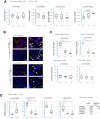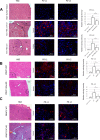The polymorphism rs975484 in the protein arginine methyltransferase 1 gene modulates expression of immune checkpoint genes in hepatocellular carcinoma
- PMID: 32245889
- PMCID: PMC7242710
- DOI: 10.1074/jbc.RA120.013401
The polymorphism rs975484 in the protein arginine methyltransferase 1 gene modulates expression of immune checkpoint genes in hepatocellular carcinoma
Abstract
Protein arginine methyltransferase 1 (PRMT1) is a key regulator of hepatic immune responses. Recently, we reported that PRMT1 regulates the tumor immune response in hepatocellular carcinoma (HCC). Here we found that PRMT1 expression in human HCC correlates with that of programmed cell death 1 ligand 1 (PD-L1), PD-L2, and other checkpoint genes. PRMT1 deletion in mice reduced PD-L1 and PD-L2 expression in tumors and reduced the efficiency of PD-1 antibody treatment in a diethylnitrosamine-induced HCC mouse model, suggesting that PRMT1 regulates the hepatic immune checkpoint. Mice had reduced PD-L1 and PD-L2 expression when PRMT1 was specifically deleted in tumor cells or macrophages, but PRMT1 deletion in dendritic cells did not alter PD-L1 and PD-L2 expression. rs975484 is a common polymorphism in the human PRMT1 gene promoter, and we found that it alters PRMT1 expression in blood monocytes and tumor-associated macrophages in human HCC. PRMT1 expression was higher in individuals with a GG genotype than in individuals with a CC genotype, and heterozygous carriers had intermediate expression. Luciferase reporter assays indicated that this differential expression is due to an extra C/EBPβ-binding site in the PRMT1 promoter of individuals carrying the minor G allele. The rs975484 genotype also correlated with PRMT1 target expression in HCC. Individuals with the GG genotype had significantly higher levels of the PRMT1 targets PD-L1, PD-L2, and VISTA than those with the CC genotype. We conclude that PRMT1 critically controls immune checkpoints in mice and humans and that the PRMT1 polymorphism rs975484 affects checkpoint gene expression in HCC.
Keywords: CCAAT-enhancer-binding protein (C/EBP); PD-L2; SNP; checkpoint control; inflammation; macrophage; programmed cell death 1 ligand 1 (PD-L1); protein arginine methyltransferase 1 (PRMT1); rs975484; tumor immunology.
© 2020 Schonfeld et al.
Conflict of interest statement
The authors declare that they have no conflicts of interest with the contents of this article. The content is solely the responsibility of the authors and does not necessarily represent the official views of the National Institutes of Health
Figures






Similar articles
-
Disruption of SIRT7 Increases the Efficacy of Checkpoint Inhibitor via MEF2D Regulation of Programmed Cell Death 1 Ligand 1 in Hepatocellular Carcinoma Cells.Gastroenterology. 2020 Feb;158(3):664-678.e24. doi: 10.1053/j.gastro.2019.10.025. Epub 2019 Oct 31. Gastroenterology. 2020. PMID: 31678303
-
Immune checkpoint molecules are regulated by transforming growth factor (TGF)-β1-induced epithelial-to-mesenchymal transition in hepatocellular carcinoma.Int J Med Sci. 2021 Apr 22;18(12):2466-2479. doi: 10.7150/ijms.54239. eCollection 2021. Int J Med Sci. 2021. PMID: 34104078 Free PMC article.
-
Atorvastatin Attenuates Programmed Death Ligand-1 (PD-L1) Induction in Human Hepatocellular Carcinoma Cells.Int J Mol Sci. 2021 Aug 15;22(16):8755. doi: 10.3390/ijms22168755. Int J Mol Sci. 2021. PMID: 34445462 Free PMC article.
-
Clinicopathologic Significance and Prognostic Value of Programmed Cell Death Ligand 1 (PD-L1) in Patients With Hepatocellular Carcinoma: A Meta-Analysis.Front Immunol. 2018 Sep 11;9:2077. doi: 10.3389/fimmu.2018.02077. eCollection 2018. Front Immunol. 2018. PMID: 30254644 Free PMC article.
-
Immunotherapy for Esophageal and Gastric Cancer.Am Soc Clin Oncol Educ Book. 2017;37:292-300. doi: 10.1200/EDBK_175231. Am Soc Clin Oncol Educ Book. 2017. PMID: 28561677 Review.
Cited by
-
Immune Phenotype and Immune Checkpoint Inhibitors for the Treatment of Human Hepatocellular Carcinoma.Cancers (Basel). 2020 May 18;12(5):1274. doi: 10.3390/cancers12051274. Cancers (Basel). 2020. PMID: 32443599 Free PMC article. Review.
-
Identification of Gene-Set Signature in Early-Stage Hepatocellular Carcinoma and Relevant Immune Characteristics.Front Oncol. 2021 Oct 22;11:740484. doi: 10.3389/fonc.2021.740484. eCollection 2021. Front Oncol. 2021. PMID: 34745960 Free PMC article.
-
PRMT1 promotes immune escape in hepatocellular carcinoma by regulating arginine methylation modification of MYC protein.Epigenetics. 2025 Dec;20(1):2509044. doi: 10.1080/15592294.2025.2509044. Epub 2025 May 22. Epigenetics. 2025. PMID: 40401713 Free PMC article.
-
PRMT1 Integrates Immune Microenvironment and Fatty Acid Metabolism Response in Progression of Hepatocellular Carcinoma.J Hepatocell Carcinoma. 2024 Jan 6;11:15-27. doi: 10.2147/JHC.S443130. eCollection 2024. J Hepatocell Carcinoma. 2024. PMID: 38213310 Free PMC article.
-
The role of histone methylase and demethylase in antitumor immunity: A new direction for immunotherapy.Front Immunol. 2023 Jan 11;13:1099892. doi: 10.3389/fimmu.2022.1099892. eCollection 2022. Front Immunol. 2023. PMID: 36713412 Free PMC article. Review.
References
Publication types
MeSH terms
Substances
Grants and funding
LinkOut - more resources
Full Text Sources
Medical
Molecular Biology Databases
Research Materials

